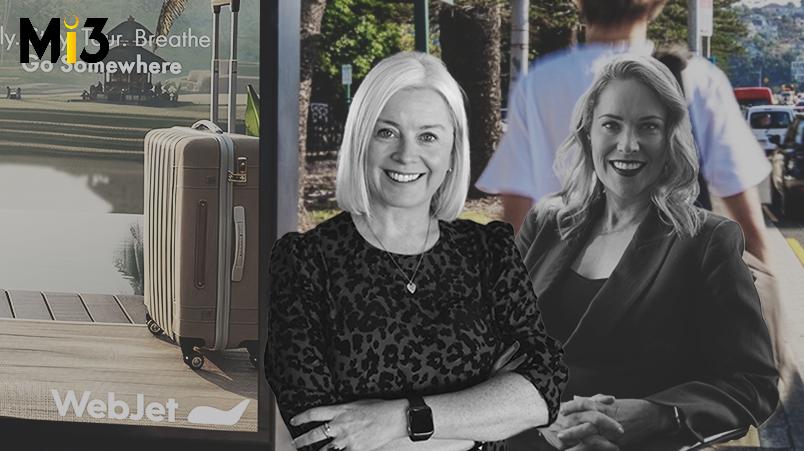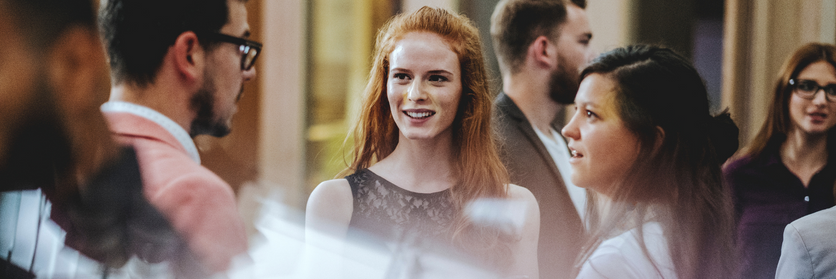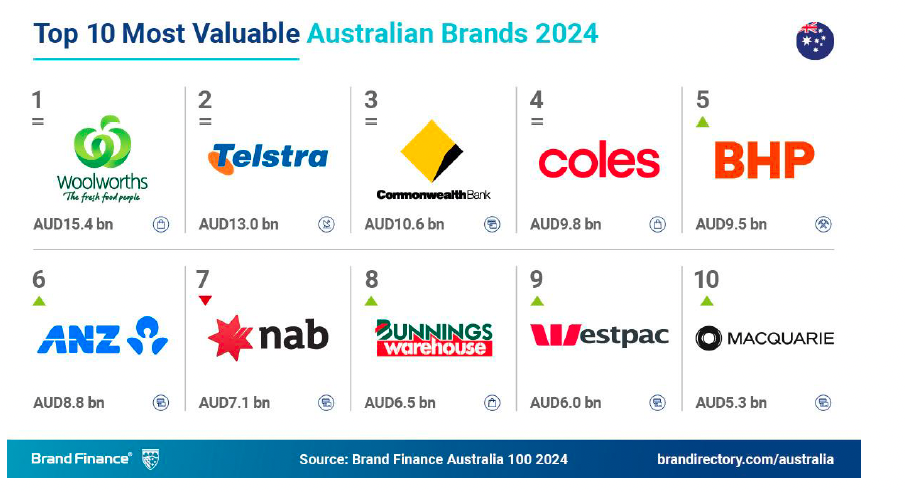Webjet CEO and CMO near double marketing spend in $3.2bn growth push, overhaul brand, tech, marketing model, plot loyalty play in bid to blow away US and Euro rivals

Webjet doesn’t just want to be known by three in four Australians as an OTA for flights. It wants to become the go-to mainstream travel companion for Australian and New Zealand consumers looking for one place to book all their travel needs.
To do that, the ASX-listed digital-first travel provider is going all-in on brand, upping marketing investment by 82 per cent over the next six months and flipping brand/performance spend from 30/70 to 70/30 as it rolls out a new brand and creative platform play.
Debuting officially last week, Webjet’s new brand campaign, ‘Go Somewhere’, was constructed together with recently installed agency, The Hallway, and reflects the first hefty brand transformation undertaken in the company’s 27-year history. This work has spanned brand and marketing strategy, visual identity, website design, a new creative platform and brand campaign, and expanded product verticals.
More volume required
The masterplan is to become the go-to local travel booking companion for mass market Australia and New Zealand consumers, leaning into the brand’s local identity and high levels of brand trust in order to bolster appeal. The work is designed to target both younger Gen Y/Z consumers and Webjet’s core 50-plus customer bases and spur the next injection of growth.
Webjet’s five-year strategy, 14 months in the making, is to double total transaction volumes (TTV) by 2030 to +$3.2 billion. The group reported 1.5 million transactions in 2024 worth $1.5 billion, chalking up revenue of $139.7 million for the group and EBITDA of $39.4m. The business demerged from B2B arm, Web Travel Group, in September 2024.
Webjet group CEO and MD, Katrina Barry, who has her own background in brand transformation work – she was MD of Contiki Australia and Trafalgar Tours before becoming a director and joining the former unified Webjet business – is convinced of the power of brand storytelling and preference to make this happen. She told Mi3 as part of the extensive strategic review, Webjet surveyed more than 3,500 customers and non-customers to deeply understand traveller needs across 10,000 journeys. This revealed Webjet had 73 per cent unprompted awareness and three in four trusted the brand, yet fewer than one in five were familiar with its offerings (15 per cent).
“The opportunity here was take a dusty brand, dust it off, and put it back to the forefront of Australia, New Zealander’s minds,” Barry says. Using the brand and customer research, she says a three-month deep strategy program ensued.
“We looked at where is tech going, where is AI going, then we asked: How do we use that? Where do we want to play? What are we great at? What are we not so good at? Where is this market moving, and where are the pots of revenue, and where is the growth rates in those individual pots of revenue, if you will? That was so we could focus on developing a very robust, commercially rational strategy that leant on what we’re really good at,” she says. “And what we’re really good at is being an Aussie and Kiwi brand that helps Australians and Kiwis across all age groups and demographics organise their travel.”
Loyalty play incoming
The problem is, Webjet is predominantly used as a flight-booking OTA, even though it has been selling hotels and holiday packages, tours and insurance for some time. “We just don’t yell about it enough,” Barry continues.
“This is not some faceless, nameless company overseas or some big European or US monolith where I can’t get service, even if I tried. This is Aussies and Kiwis, and world-class tech. We make this effortless, we make it really empowering, and we just help you organise your holidays, your travel.”
The good news is Webjet is the number one OTA in Australia, per Barry. “But we knew that we had to make it bigger, make it better,” says Barry. “It’s a really bold and transformational shift of the whole business. It’s not just a brand campaign or a marketing glow up.”
Barry points to the distinctive way ANZ constituents travel compared to Europeans and Americans as a case for why local travel companies matter: They travel point to point; we travel multi-point. Webjet’s research work also found 74 per cent of people want to buy everything in one place. In response, Webjet is using AI to help build multi-stop trips, with built-in discounts. It’s also introduced new products tours and increasing its packaging plays – take the Bali flop-and-drop, and Thailand flop-and-drop tour examples.
“We need to build this new level of familiarity and new levels of loyalty – we are absolutely going to be launching a loyalty program next year – and become the first choice for Aussies and Kiwis who travel. That meant seriously levelling up our marketing,” says Barry. “Which is why I needed to hire a gun CMO, who was really experienced in brand transformation.”
As we grow and build that price elasticity, and our brand becomes more powerful, we need to deeply understand our products. I've got a new product marketing function focused on really understanding the features of the product for each vertical that we can then turn into really compelling value propositions for customers.
CMO game plan
Enter Webjet group’s first chief marketing officer, Oonagh Flanagan, who took up the reins six months ago.
Flanagan doesn’t shy away from marketing rebuilds – it’s what she did in her last CMO gig at Funlabs, which owns entertainment brands including Archie Brothers, Strike bowling and Holey Moley. Describing that role as a “baptism of fire” to Mi3 two years into her tenure there, Flanagan was responsible for a $1.2m booking system rebuild, bringing in Salesforce Cloud to connect marketing to sales and service and form a single view of customer, and helping ensure online sales climbed to 35-40 per cent of total revenue.
Coming in as Webjet’s first Webjet CMO, Flanagan was delighted to find the wealth of fresh customer research data on hand, along with the firm strategic plan and ambitions. The Hallway had been appointed creative and brand agency partner prior to Flanagan’s appointment.
“It would have been really easy for us just to do the glow up in terms of the visuals, but as Katrina said, that wouldn’t have really helped to transform the entire business. So we went pretty deep and actually redid our strategy on a page from a brand perspective,” Flanagan says. “That created the foundation for everything across the business, not just from a marketing point of view. That’s been really helpful for everyone across the business when they’re starting to look at prioritisation and the workload, to make sure that all that ladders up to the same thing.”
Structural overhaul
What needed evolving was marketing operational structure and skillsets. Flanagan has recruited a CRM and personalisation manager to up capability in this area, and deployed Braze as Webjet’s new customer engagement platform.
What was also critically important for Flanagan was to build a strong product marketing muscle. “This is about having someone internally who deeply understands each of the product verticals through the marketing lens. That’s important, because we’ve been highly focused, mainly because of the macroeconomic environment, on discount deals, sales and price-led initiatives,” she explains.
“As we grow and build that price elasticity, and our brand becomes more powerful, we need to deeply understand our products. I’ve got a new product marketing function focused on really understanding the features of the product for each vertical that we can then turn into really compelling value propositions for customers.”
Clear marketing and media planning is another one of Flanagan’s mantras. She’s been striving to map out the six,12 and 18-month plan for marketing, not just at a brand campaign level, but also “what we’re doing above-the-line to the travel beat, and how the Australian and Kiwi public actually book travel, and what’s interesting to them at any given time”.
“It’s making sure we’ve got that real through the line focus to make everything work harder and ultimately increase conversion for the people we bring to the sites,” Flanagan says.
Webjet has also revitalised its website design, shifting to a headless CMS format to cope with the expansion of its hotel, packages, tours and business travel offerings. Flanagan is now onboarding Mutinex’s market mix modelling (MMM) platform to further demonstrate the impact of brand investment.
“It has been a steep learning curve, but the one thing I really loved when I joined the organisation was just the deep lack of ego. People just really want to learn… What we hope next year, as we start to prove some results from the campaign, we’ll augment the team further. But for right now, I think we’ve got the right sort of foundations in place,” she says.
Lots of consumer brands fell into that trap of just pushing all their performance down the end, because that's easy to talk to boards about; we spent this, and we delivered this. But that's certainly not how you create brands or how you create legacy. I remember saying even 10 years ago, you need to push it up here, guys, we need to be thinking about first-party data, and brand marketing, because that is what to create for long-term value. It's really easy to correct some short-term wins and get addicted to the drive at the bottom of the performance marketing.”
Backing the brand narrative
Webjet’s fresh brand campaign centres around the idea ‘Go somewhere’, and is designed to be local without too much colloquialism to appeal to mass market, centred in the excitement of travel and contemporary. The first cross-channel creative campaign employs witty stop-motion films directed by award-winning filmmaker Spencer Susser, showing suitcases spilling their owners’ secrets as they break out of everyday routines to go travelling.
Mining 12 months’ worth of sales data to April 2025 showed two-thirds of TTV came from direct and branded sources, further building the argument for a brand-led approach. In addition, customers who arrive directly to Webjet’s site or via organic search are 1.5 times more likely to convert, and are worth at least 30 per cent more in terms of TTV than those sourced through less brand-oriented channels. Such data has given Webjet’s marketing team “the confidence to forge ahead” despite the ongoing uncertainty of the macro-economic climate, says Flanagan.
As a result, she’s flipping the brand / performance mix from 30/70 to 70/30. There’s also rapid extension into more channels, with TV, CTV, cinema, online video, social, out-of-home all coming into the mix. Early next year, there will be substantial use of audio and podcast platforms. All this is backed by an 82 per cent increase in marketing investment compared to the previous six months.
“Lots of consumer brands fell into that trap of just pushing all their performance down the end, because that’s easy to talk to boards about; we spent this, and we delivered this,” comments Barry. “But that’s certainly not how you create brands or how you create legacy. I remember saying even 10 years ago, you need to push it up here, guys, we need to be thinking about first-party data, and brand marketing, because that is what to create for long-term value. It’s really easy to correct some short-term wins and get addicted to the drive at the bottom of the performance marketing.”
It’s also shoring up Webjet’s ability to ride the uncertainty throughline persisting in market. As Barry puts it, no one in the travel industry is “swinging on the chandeliers, buying French champagne right now”. “It is a tough economic market and in Australia – we’re not in a club of one, it’s the whole travel industry that’s tighter,” she says.
In-house vs agency
As a CMO, Flanagan has a decided preference to build in-house capabilities over extensive agency use. But that just hasn’t been possible given the existing marketing skills when she arrived, and the pace at which Webjet is transforming. A key reason she appointed Nunn Media as media agency of record was the skills transfer that will come from working with that team.
“We had to move fast. So I needed agencies that I could trust, and agencies who had gravitas and who had proven their capability ultimately,” Flanagan comments. “What won it for them [Nunn Media] beyond pace was actually their commitment to upskilling the teams of the businesses that they work with. They have an academy process where they actually help you upskill your team internally… Media buying historically at Webjet has been quite distributed, and not really done from the perspective of actually buying audiences. It’s really difficult to teach that quickly, so I had to buy that skill. Also this is an agency who’s committed to helping me to in-house over time. Because, again, not every agency really wants to do that.”
Flanagan didn’t choose The Hallway, but “I’m really glad that someone else did, because I think their capability around brand strategy and customer or channel planning at that really strategic level has been really important”, she says. “Again, we don’t have that skillset in-house, because it hasn’t really been important up to this point.”
Paid search is the third spoke in the wheel. “Again, I much prefer that to be in-house, but I wanted a small agency with people who I’ve worked with before, who I knew were going to treat every dollar and cent as if it was their own money and that’s how I came to decision on Spike Digital,” says Flanagan.
AI search shake-up
Given the rapid transformation of search as AI and LLM use rises, Flanagan also reveals she’s working to rebuild the relationship with Google. “I want to make sure we’re really close to what’s happening and what Google knows, but also starting to prepare ourselves,” she says.
“Content is really, really important for us, and we’d under invested, I think, in our SEO capability, which actually has a knock-on impact on what’s happening in search overall. We’ve done the deep audit work on SEO and we know the challenges we face, and we know the hill we have to climb. As we get past the initial part of the brand launch, my focus is going to turn to that, because that’s really future proofing us as best we can.”
For her part, Barry isn’t convinced the ChatGPTs of the world are going to completely take over travel itinerary planning either – she’s still banking on brand differentiation and trust.
“Google flights was an existential threat to this business 10 years ago; they take up so little market share, nobody’s worried about them today in travel distribution,” she argues. “You can’t call anyone. There’s no accuracy, and there’s no human face behind it. AI is going to be great, it’s going to make us all so much more effective and efficient, and we are going to lean into that to make sure that we create unique product that can’t easily be compared. But it’s never going to replace brand and trust.”
Commercial runway
As to judging the brand work’s success, Flanagan and Barry insist the initial few months is about ensuring the “grand” brand narrative just gets out there.
“Next year, I said to Oonagh, I want you to focus on our USPs – the fact you can get 20 per cent off hotels, and the fact that you can do it all here. That also gives my tech team time to catch up and sew together little bits and pieces,” Barry says.
“Certainly from a screens point of view, we’re really focused on the destination,” continues Flanagan. “Ultimately, when you feature a destination and encourage someone to go to a destination, it’s almost implied and inferred there’s a set of things you have to do, and the idea we offer the ability to do all of those.
“We’ve probably taken a slightly different approach in the consideration kind of part of the funnel. It’s very heavily leaning into brand, but we’re starting to then build in the different verticals to messaging as we move into that middle of funnel phase. You’ll start to see that across out-of-home, particularly in audio and podcasts, where we’re choosing certain avenues essentially to bring to life that product specific, or vertical specific messaging.
“And yes, we’re still trying to convert people at the bottom of the funnel. At the moment, we’re looking at plenty of messages around product, but potentially also starting to bring some of those retail messages in.”
As Barry put it, if Webjet can get one more hotel booking for every flight sold on its website, “we are off to the races”.
“That is what I need to think about in terms of brand delivering value to our shareholders,” she adds.





